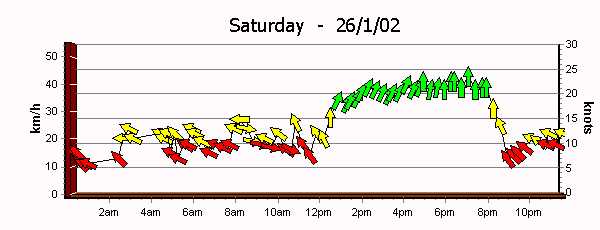 his diagram shows a typical synoptic situation
that produces wind in
Western Australia over the summer months.
his diagram shows a typical synoptic situation
that produces wind in
Western Australia over the summer months.
 his diagram shows a typical synoptic situation
that produces wind in
Western Australia over the summer months.
his diagram shows a typical synoptic situation
that produces wind in
Western Australia over the summer months.
The climate is quite warm, with temperatures ranging typically from 25 - 39 deg Celsius. The windy days are usually those that lie between 25 - 32 degrees, since the lower temperature is usually due to the early onset of the sea breeze, cooling what otherwise would have been a 'stinking hot' day. This breeze is known as the 'Fremantle Doctor' in Perth, and comes in along the coast from Fremantle in the south (and doubtless lower) to well past Carnarvon in the north.
The following graph (from the excellent resource SeaBreeze) (see below) shows the wind movements on a typical sea breeze day. The wind is easterly - south easterly during the night and morning, and the S-SW sea breeze kicks in (suddenly) at about 12.30am. You have to experience it to believe it. The first indication of the breeze is the smell of the ocean.

This link displays a map of WA. You can click on the appropriate area to get the weather details.
The current wind observations in Perth can be found here.
The current synoptic chart can be viewed here.
Current WA Observations can be found here.
An excellent resource is SeaBreeze. It is amazingly well done and extremeley useful. It is a must for the serious sailboarder and kitesurfer.
The WA coast is divided into Metro (around Perth), North West (Gnaraloo - Geraldton) and South West (Busselton - Esperance). For each region you can browse both Today's and Yesterday's wind graphs. The Today's graph pages also show the 7 day forecast conditions.
The links below take you directly to some very useful pages.
| Metro | Yesterday | Today |
| North West | Yesterday | Today |
| South West | Yesterday | Today |
The Surf Cam website http://www.coastalwatch.com/camera/cameraOverview.aspx provides access to views of Margaret River, Yallingup, Cottesloe, Scarborough and Trigg Beach.

The diagram above shows the proportion of the time that the wind is in excess of 20 km / hr, for various locations for the whole year. This information is taken from historical data averaged over 40 or so years, purchased from the Australian Bureau of Meteorology. It is unfortunate that the reference speed is 20 km / hr, I would have preferred 15 or 20 knots, however that is the speed that the figures are published at. 20 km / hr is about 13 knots, which is just too marginal for a wave board really.
Swanbourne shows the conditions near Perth. The Margaret River data is actually that of Cape Naturaliste, which has more relevance to the sailing conditions at Margaret River than the actual wind station, which is quite inland. The Lancelin wind station is also protected by some sand dunes in the area, and the figures are somewhat lighter than the offshore winds. Lancelin should probably be somewhere between Swanbourne and Geraldton.
Carnarvon can be taken as a good indication of the conditions at Gnaraloo and Coral Bay, which unfortunately don't have wind monitoring stations.
As it can be seen, the season is mainly between Mid November and February. It can also be seen that the wind starts earlier in the Gnaraloo area, around October and November, and that Esperance runs later than the Lancelin / Geraldton area.
The 1999-2000 season was the worst in living memory for most of the coast. A tropical cyclone on the North West coast left a low pressure in the area, which pushed all the standard weather patterns under the Australian continent (see chart 1 and chart 2. The season had started well during November and some good consistent winds were experienced. The cyclone came in mid December, and caused in excess of 2 months of very marginal conditions. This has not occurred in the 18 years previous to this. The low pressure is still having an effect in March 2000.
This season was the longest for several years. It started early, but unfortunately had 2 - 3 weeks of hiatus over the new year. The season started at the end of September and lasted till the end of April. In December there was a record of 28 straight sailing days (wave sailing conditions, 4 -5.5 m).
| Previous | Home | Next | ||
|---|---|---|---|---|
| General | Travel/Visa |